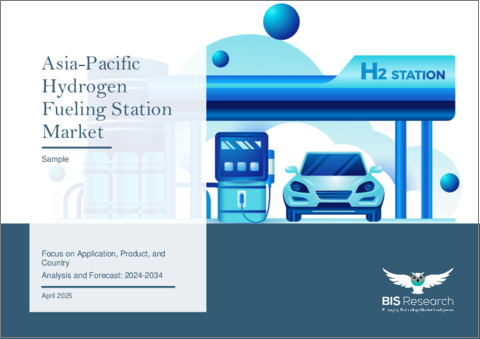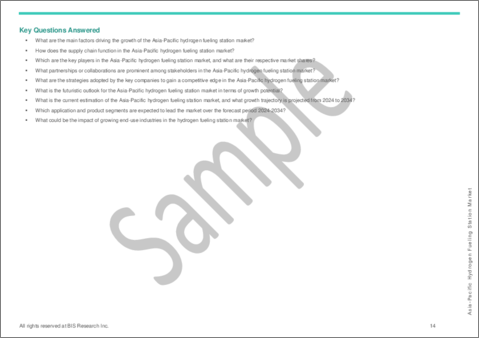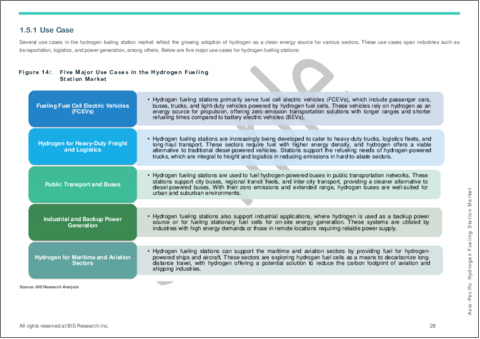|
|
市場調査レポート
商品コード
1700010
アジア太平洋の水素燃料ステーション市場:用途別、製品別、国別 - 分析と予測(2024年~2034年)Asia-Pacific Hydrogen Fueling Station Market: Focus on Application, Product, and Country - Analysis and Forecast, 2024-2034 |
||||||
カスタマイズ可能
|
|||||||
| アジア太平洋の水素燃料ステーション市場:用途別、製品別、国別 - 分析と予測(2024年~2034年) |
|
出版日: 2025年04月10日
発行: BIS Research
ページ情報: 英文 86 Pages
納期: 1~5営業日
|
全表示
- 概要
- 図表
- 目次
アジア太平洋の水素燃料ステーションの市場規模は、2024年の1億4,420万米ドルから2034年には10億5,360万米ドルに達し、2024年~2034年の予測期間中に22.00%のCAGRで拡大すると予測されています。
環境の持続可能性に対する懸念の高まりと化石燃料への依存度を減らす必要性から、水素充填ステーション市場は最近注目を集めています。燃料電池自動車(FCV)は、クリーンで再生可能なエネルギー源である水素を燃料としており、輸送中に排出ガスを出しません。
| 主要市場統計 | |
|---|---|
| 予測期間 | 2024年~2034年 |
| 2024年の評価 | 1億4,420万米ドル |
| 2034年の予測 | 10億5,360万米ドル |
| CAGR | 22% |
アジア太平洋の水素燃料ステーション市場は、環境の持続可能性と二酸化炭素排出量の削減が重視されるようになり、急速に拡大しています。戦略的エネルギー・イニシアティブの一環として、中国、日本、韓国を含むアジア太平洋の政府は、水素インフラに多額の投資を行っています。これらの国々は、水素燃料電池自動車(FCV)の開発を先導し、大規模な水素供給ネットワークの構築を支援しています。化石燃料への依存を減らし、人口密度の高い都市部の空気の質を高める必要性が、よりクリーンなエネルギー・ソリューションの必要性を高めています。水素製造・貯蔵技術が大幅に進歩した結果、市場は拡大しています。有利な政府規制、多額の財政支援、主要な業界参入企業による協力的な取り組みにより、アジア太平洋の水素燃料ステーション市場は大きな成長を遂げ、同地域は水素経済とクリーンエネルギー移行における世界的リーダーとして位置づけられています。
水素貯蔵、ディスペンシングシステム、安全対策における技術的進歩は、水素充填ステーションの実現可能性と拡張性をさらに高めています。市場は、高い資本コストや限られたステーション密度といった課題に直面しているが、継続的な技術革新と強力な官民パートナーシップにより、これらの障壁を克服し、持続可能な成長を促進することが期待されます。
政府の強力な支援、水素モビリティ・プロジェクトへの大規模な投資、商用および公共交通セクターにおける燃料電池自動車への需要拡大が、アジア太平洋の水素充填ステーション市場の主な促進要因です。同市場はまた、急速なインフラ開発と再生可能エネルギーの統合が進んでいることも特徴です。市場がさらに急成長するためには、水素貯蔵に関する技術的問題、安全規制、運用の有効性も解決しなければなりません。アジア太平洋に持続可能な水素エコシステムを構築し、水素燃料供給インフラが世界中で長期的に存続することを保証するためには、戦略的提携、より多くの資金調達、技術開発を通じてこれらの障害を克服することが不可欠です。
アジア太平洋の水素燃料ステーション市場は、ステーションの規模、ステーションのタイプ、供給タイプ、エンドユーザーなど、様々なカテゴリーに基づいて広範にセグメント化されています。これにより、読者は、どのセグメントが最大のシェアを占め、どのセグメントが今後数年間で成長する可能性が高いかを明確に把握することができます。
アジア太平洋の水素燃料ステーション市場は、事業拡大、提携、協力、合弁など、同市場で事業を展開する主要企業による大きな開拓が見られます。
当レポートでは、アジア太平洋の水素燃料ステーション市場について調査し、市場の概要とともに、用途別、製品別、国別の動向、および市場に参入する企業のプロファイルなどを提供しています。
目次
エグゼクティブサマリー
第1章 市場:業界展望
- 動向:現状と将来への影響評価
- 地域戦略と影響
- アジア太平洋の水素戦略と水素燃料ステーションの成長への影響
- サプライチェーンの概要
- バリューチェーン分析
- 水素燃料ステーション市場マップ(ステーションタイプ別)
- 研究開発レビュー
- 規制状況
- ステークホルダー分析
- 使用事例
- エンドユーザーと購入基準
- 水素燃料ステーションの容量とコストの評価
- 水素燃料ステーションを活用している主な企業
- エコシステム/進行中のプログラム
- 市場力学の概要
- 市場の促進要因
- 市場の課題
- 市場の機会
第2章 地域
- 地域サマリー
- アジア太平洋
- 地域概要
- 市場成長測員要員
- 市場成長抑制要因
- 中国
- 日本
- オーストラリア
- 韓国
- その他
第3章 市場-競合ベンチマーキングと企業プロファイル
- 今後の見通し
- 地理的評価
- Iwatani Corporation
第4章 調査手法
List of Figures
- Figure 1: Asia-Pacific Hydrogen Fueling Station Market (by Scenario), $Billion, 2025, 2028, and 2034
- Figure 2: Hydrogen Fueling Station Market (by Region), $Million, 2024, 2028, and 2034
- Figure 3: Asia-Pacific Hydrogen Fueling Station Market (by Application), $Million, 2024, 2028, and 2034
- Figure 4: Asia-Pacific Hydrogen Fueling Station Market (by Station Size), $Million, 2024, 2028, and 2034
- Figure 5: Asia-Pacific Hydrogen Fueling Station Market (by Station Type), $Million, 2024, 2028, and 2034
- Figure 6: Asia-Pacific Hydrogen Fueling Station Market (by Supply Type), $Million, 2024, 2028, and 2034
- Figure 7: Asia-Pacific Hydrogen Fueling Station Market (by Solution Type), $Million, 2024, 2028, and 2034
- Figure 8: Asia-Pacific Hydrogen Fueling Station Market (by Pressure), $Million, 2024, 2028, and 2034
- Figure 9: Key Events
- Figure 10: Recent Government Initiatives in Hydrogen Fueling Station Market
- Figure 11: Hydrogen Refueling Stations, APAC, 2022
- Figure 12: Patent Filed (by Country), January 2021-December 2024
- Figure 13: Patent Filed (by Company), January 2021-December 2024
- Figure 14: Five Major Use Cases in the Hydrogen Fueling Station Market
- Figure 15: Impact Analysis of Hydrogen Fueling Station Market Navigating Factors, 2024-2034
- Figure 16: Total Number of FCEVs in the World, 2019-2023, Thousand Units
- Figure 17: China Hydrogen Fueling Station Market, $Million, 2024-2034
- Figure 18: Japan Hydrogen Fueling Station Market, $Million, 2024-2034
- Figure 19: Australia Hydrogen Fueling Station Market, $Million, 2024-2034
- Figure 20: South Korea Hydrogen Fueling Station Market, $Million, 2024-2034
- Figure 21: Rest-of-Asia-Pacific Hydrogen Fueling Station Market, $Million, 2024-2034
- Figure 22: Strategic Initiatives, January 2021-December 2024
- Figure 24: Data Triangulation
- Figure 25: Top-Down and Bottom-Up Approach
- Figure 26: Assumptions and Limitations
List of Tables
- Table 1: Market Snapshot
- Table 2: Opportunities across Region
- Table 3: Key R&D Investments in Hydrogen Vehicles
- Table 4: Recent Developments of Advanced Hydrogen Production Technologies
- Table 5: Component Companies Involved in the Construction of Refueling Stations
- Table 6: Component Cost of Hydrogen Fueling Station, Asia-Pacific
- Table 7: Companies Utilizing Hydrogen-Powered Fuel Stations
- Table 8: Recent Incentives Focussing on FCEVs
- Table 9: Recent Projects Conducted by Research Institutes on the Hydrogen Fueling Station Market
- Table 10: Hydrogen Fueling Station Market (by Region), $Million, 2024-2034
- Table 11: Asia-Pacific Hydrogen Fueling Station Market (by Application), $Million, 2024-2034
- Table 12: Asia-Pacific Hydrogen Fueling Station Market (by Station Size), $Million, 2024-2034
- Table 13: Asia-Pacific Hydrogen Fueling Station Market (by Station Type), $Million, 2024-2034
- Table 14: Asia-Pacific Hydrogen Fueling Station Market (by Supply Type), $Million, 2024-2034
- Table 15: Asia-Pacific Hydrogen Fueling Station Market (by Solution), $Million, 2024-2034
- Table 16: Asia-Pacific Hydrogen Fueling Station Market (by Pressure), $Million, 2024-2034
- Table 17: China Hydrogen Fueling Station Market (by Application), $Million, 2024-2034
- Table 18: China Hydrogen Fueling Station Market (by Station Size), $Million, 2024-2034
- Table 19: China Hydrogen Fueling Station Market (by Station Type), $Million, 2024-2034
- Table 20: China Hydrogen Fueling Station Market (by Supply Type), $Million, 2024-2034
- Table 21: China Hydrogen Fueling Station Market (by Solution), $Million, 2024-2034
- Table 22: China Hydrogen Fueling Station Market (by Pressure), $Million, 2024-2034
- Table 23: Japan Hydrogen Fueling Station Market (by Application), $Million, 2024-2034
- Table 24: Japan Hydrogen Fueling Station Market (by Station Size), $Million, 2024-2034
- Table 25: Japan Hydrogen Fueling Station Market (by Station Type), $Million, 2024-2034
- Table 26: Japan Hydrogen Fueling Station Market (by Supply Type), $Million, 2024-2034
- Table 27: Japan Hydrogen Fueling Station Market (by Solution), $Million, 2024-2034
- Table 28: Japan Hydrogen Fueling Station Market (by Pressure), $Million, 2024-2034
- Table 29: Australia Hydrogen Fueling Station Market (by Application), $Million, 2024-2034
- Table 30: Australia Hydrogen Fueling Station Market (by Station Size), $Million, 2024-2034
- Table 31: Hydrogen Fueling Station Market (by Station Type), $Million, 2024-2034
- Table 32: Australia Hydrogen Fueling Station Market (by Supply Type), $Million, 2024-2034
- Table 33: Australia Hydrogen Fueling Station Market (by Solution), $Million, 2024-2034
- Table 34: Australia Hydrogen Fueling Station Market (by Pressure), $Million, 2024-2034
- Table 35: South Korea Hydrogen Fueling Station Market (by Application), $Million, 2024-2034
- Table 36: South Korea Hydrogen Fueling Station Market (by Station Size), $Million, 2024-2034
- Table 37: South Korea Hydrogen Fueling Station Market (by Station Type), $Million, 2024-2034
- Table 38: South Korea Hydrogen Fueling Station Market (by Supply Type), $Million, 2024-2034
- Table 39: South Korea Hydrogen Fueling Station Market (by Solution), $Million, 2024-2034
- Table 40: South Korea Hydrogen Fueling Station Market (by Pressure), $Million, 2024-2034
- Table 41: Rest-of-Asia-Pacific Hydrogen Fueling Station Market (by Application), $Million, 2024-2034
- Table 42: Rest-of-Asia-Pacific Hydrogen Fueling Station Market (by Station Size), $Million, 2024-2034
- Table 43: Rest-of-Asia-Pacific Hydrogen Fueling Station Market (by Station Type), $Million, 2024-2034
- Table 44: Rest-of-Asia-Pacific Hydrogen Fueling Station Market (by Supply Type), $Million, 2024-2034
- Table 45: Rest-of-Asia-Pacific Hydrogen Fueling Station Market (by Solution), $Million, 2024-2034
- Table 46: Rest-of-Asia-Pacific Hydrogen Fueling Station Market (by Pressure), $Million, 2024-2034
- Table 47: Market Share, 2023
Introduction to Asia-Pacific (APAC) Hydrogen Fueling Station Market
The Asia-Pacific hydrogen fueling station market is projected to reach $1,053.6 million by 2034 from $144.2 million in 2024, growing at a CAGR of 22.00% during the forecast period of 2024-2034. Due to growing concerns about environmental sustainability and the need to lessen reliance on fossil fuels, the market for hydrogen fuelling stations has received much attention lately. Fuel cell vehicles (FCVs) run on hydrogen, a clean and renewable energy source that produces no emissions during transportation.
Market Introduction
| KEY MARKET STATISTICS | |
|---|---|
| Forecast Period | 2024 - 2034 |
| 2024 Evaluation | $144.2 Million |
| 2034 Forecast | $1,053.6 Million |
| CAGR | 22% |
The market for hydrogen fueling stations in the Asia-Pacific (APAC) region is expanding rapidly due to the growing emphasis on environmental sustainability and the reduction of carbon emissions. As a component of their strategic energy initiatives, governments in Asia-Pacific, including those of China, Japan, and South Korea, are making significant investments in hydrogen infrastructure. These countries are leading the way in the creation of hydrogen fuel cell vehicles (FCVs) and assisting in the construction of large-scale hydrogen fueling networks. The need to reduce dependency on fossil fuels and enhance air quality in densely populated urban areas is driving the need for cleaner energy solutions. The market is growing as a result of significant advancements in hydrogen production and storage technologies. Thanks to favorable government regulations, significant financial support, and cooperative endeavors from major industry participants, the APAC hydrogen fueling station market is poised for significant growth, positioning the region as a global leader in the hydrogen economy and clean energy transition.
Technological advancements in hydrogen storage, dispensing systems, and safety measures are further enhancing the feasibility and scalability of hydrogen fuelling stations. While the market faces challenges such as high capital costs and limited station density, ongoing innovation and strong public-private partnerships are expected to overcome these barriers and drive sustainable growth.
Market Segmentation
Segmentation 1: by Application
- Light-Duty Vehicles
- Heavy-Duty Vehicles
- Mixed
Segmentation 2: by Station Size
- Small-Size Stations
- Mid-Size Stations
- Large Stations
Segmentation 3: by Station Type
- Fixed Hydrogen Station
- Mobile Hydrogen Station
Segmentation 4: by Supply Type
- Off-Site
- Gas
- Liquid
- On-Site
- Electrolysis
- Steam Methane Reforming
Segmentation 5: by Solution Type
- Engineering, Procurement, and Construction
- Components
- Hydrogen Inlets
- Compressors
- Hydraulic Power Units and Controls
- Dispensing Chiller Systems
- Storage Units
- Dispensers
- Others
Segmentation 6: by Pressure
- Low Pressure
- High Pressure
- Hybrid
Segmentation 7: by Country
- China
- Japan
- South Korea
- Australia
- Rest-of-Asia-Pacific
Market Trends, Drivers and Challenges of APAC Hydrogen Fuelling Station Market
Strong government support, significant investments in hydrogen mobility projects, and the growing demand for fuel cell vehicles across the commercial and public transport sectors are the main drivers of the APAC hydrogen fuelling station market, which is expanding dynamically due to regional initiatives to reduce carbon emissions and support the adoption of clean energy. The market is also characterised by rapid infrastructure development and increasing integration of renewable energy source. For the market to grow more quickly, technological issues with hydrogen storage, safety regulations, and operational effectiveness must also be resolved. It will be essential to overcome these obstacles through strategic alliances, more financing, and technological developments in order to create a sustainable hydrogen ecosystem in the Asia-Pacific area and guarantee the long-term viability of hydrogen fuelling infrastructure worldwide.
How can this report add value to an organization?
Product/Innovation Strategy: The APAC hydrogen fueling station market has been extensively segmented based on various categories, such as station size, station type, supply type, and end users. This can help readers get a clear overview of which segments account for the largest share and which ones are well-positioned to grow in the coming years.
Growth/Marketing Strategy: The APAC hydrogen fueling station market has seen major development by key players operating in the market, such as business expansion, partnership, collaboration, and joint venture.
Competitive Strategy: Key players in the APAC hydrogen fueling station market analyzed and profiled in the study involve established and emerging players. Moreover, a detailed competitive benchmarking of the players operating in the APAC hydrogen fueling station market has been done to help the reader understand how players stack against each other, presenting a clear market landscape. Additionally, comprehensive competitive strategies such as partnerships, agreements, and collaborations will aid the reader in understanding the untapped revenue pockets in the market.
Table of Contents
Executive Summary
Scope and Definition
1 Market: Industry Outlook
- 1.1 Trends: Current and Future Impact Assessment
- 1.1.1 Growing Investments in Research and Development Activities for Hydrogen Vehicles
- 1.1.2 Development of Advanced Hydrogen Production Technologies
- 1.1.3 Increased Involvement from Private and Government Sector
- 1.2 Regional Strategy and Impact
- 1.2.1 Asia-Pacific Hydrogen Strategy and its Impact on Hydrogen Fueling Stations Growth
- 1.3 Supply Chain Overview
- 1.3.1 Value Chain Analysis
- 1.3.2 Market Map of Hydrogen Fueling Station Market (By Station Type)
- 1.3.2.1 Fixed Hydrogen Station
- 1.3.2.2 Mobile Hydrogen Station
- 1.4 Research and Development Review
- 1.4.1 Patent Filing Trend (by Country and Company)
- 1.5 Regulatory Landscape
- 1.6 Stakeholder Analysis
- 1.6.1 Use Case
- 1.6.2 End User and Buying Criteria
- 1.7 Hydrogen Fueling Station Capacity and Cost Assessment
- 1.7.1 Dispensing Capacity Trend
- 1.7.1.1 Liquid Hydrogen and Gaseous Hydrogen (by Form)
- 1.7.2 Cost Assessment of Fuel Stations
- 1.7.2.1 Trend
- 1.7.2.2 Regional Trend
- 1.7.2.2.1 Asia-Pacific
- 1.7.1 Dispensing Capacity Trend
- 1.8 Key Companies Utilizing Hydrogen-Powered Fuel Stations
- 1.9 Ecosystem/Ongoing Programs
- 1.9.1 Incentives for Hydrogen Fuel-Powered Vehicles
- 1.9.2 University Research Programs
- 1.9.3 Consortiums and Associations
- 1.1 Market Dynamics Overview
- 1.10.1 Market Drivers
- 1.10.1.1 Increasing Adoption of Fuel Cell Electric Vehicles
- 1.10.1.2 Technological Advancements in Hydrogen Fueling
- 1.10.2 Market Challenges
- 1.10.2.1 High Initial Cost of Hydrogen Fueling Station
- 1.10.2.2 Insufficiently Developed Hydrogen Infrastructure
- 1.10.3 Market Opportunities
- 1.10.3.1 Increasing Advancements in Hydrogen Technologies
- 1.10.3.2 Increasing Government Support in Green Fuels
- 1.10.1 Market Drivers
2 Region
- 2.1 Regional Summary
- 2.2 Asia-Pacific
- 2.2.1 Regional Overview
- 2.2.2 Driving Factors for Market Growth
- 2.2.3 Factors Challenging the Market
- 2.2.3.1 Application
- 2.2.3.2 Product
- 2.2.4 China
- 2.2.4.1 Application
- 2.2.4.2 Product
- 2.2.5 Japan
- 2.2.5.1 Application
- 2.2.5.2 Product
- 2.2.6 Australia
- 2.2.6.1 Application
- 2.2.6.2 Product
- 2.2.7 South Korea
- 2.2.7.1 Application
- 2.2.7.2 Product
- 2.2.8 Rest-of-Asia-Pacific
- 2.2.8.1 Application
- 2.2.8.2 Product
3 Markets - Competitive Benchmarking & Company Profiles
- 3.1 Next Frontiers
- 3.2 Geographic Assessment
- 3.2.1 Iwatani Corporation
- 3.2.1.1 Overview
- 3.2.1.2 Top Competitors
- 3.2.1.3 Top Products/Product Portfolio
- 3.2.1.4 Target Customers
- 3.2.1.5 Key Personnel
- 3.2.1.6 Analyst View
- 3.2.1.7 Market Share, 2023
- 3.2.1 Iwatani Corporation
4 Research Methodology
- 4.1 Data Sources
- 4.1.1 Primary Data Sources
- 4.1.2 Secondary Data Sources
- 4.1.3 Data Triangulation
- 4.2 Market Estimation and Forecast





